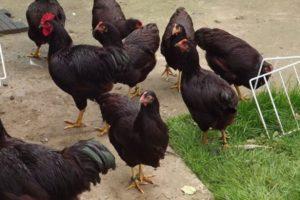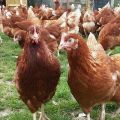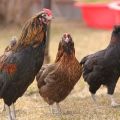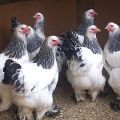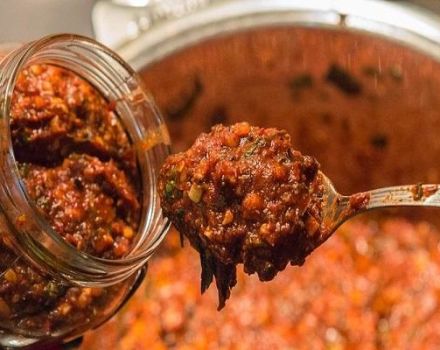Description of the breed of chickens Kuchinsky Jubilee, breeding and egg production
Often summer residents want to start chickens on their farm, but they are afraid of numerous difficulties, the occurrence of diseases during growing, they fear the death of the bird. But there is no need to worry, the main thing is the correct choice of the breed. The breeders have bred an unpretentious, productive and adapted breed to the harsh climatic conditions - Kuchinskaya or Kuchinskaya Yubileinaya.
The origin of the breed
Breed Kuchinskaya Jubilee ", or in common people - Kuchinka, was bred in 1990. The work was carried out by domestic breeders at the Kuchinsky poultry farm located in the Moscow region.
The selection was carried out for 40 years until the desired characteristics of the chickens were achieved. Breeders have combined the best of 6 breeds in one. The hens took the best qualities from foreign breeds: meat productivity, high and stable egg production, the vitality of chickens and a strong, strong constitution.
Description and characteristics of chickens Kuchinskaya Jubilee
Both chickens and roosters of the breed are united by a fleshy, dense body, a wide skeleton and a significant mass. The body is elongated, with medium, strong wings, a horizontal back and a convex, proud, broad chest. The head is of medium size. Chickens have a developed, thickened comb, consisting of 5 teeth. The bird's beak is strong, bent downwards. The eyes are large and prominent.
The neck is flexible and long, covered with a thick collar that falls over the bird's shoulders. The breed is characterized by high and stable performance, initially bred as an egg and meat breed. They are distinguished by unpretentiousness in care and good tolerance to temperature changes. Legs are medium in length, stable, with developed, strong muscles. The tail is medium, with a small span, the plumage is superimposed on each other, the braids are large and long.
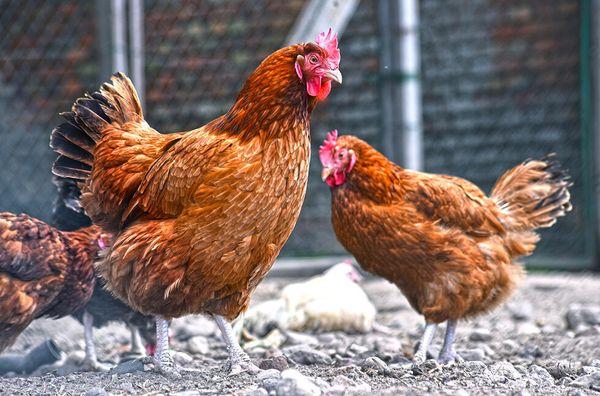
Varieties of colors
Kuchinsky Jubilee has 2 types of colors, both chickens and roosters. It is a fringed and double-edged variety.
Edged
Roosters have a bright, bay head with a golden tint. Longitudinal black stripes are located along each feather shaft, merging at the end into a dark spot. The collar on the neck is black, with a golden-brown edging at the top. The tail feathers are dominated by black and brownish-golden plumage. The breast and wings are golden brown, with a marked dark edging on each feather.The rooster has dark gray undercoats, yellowish legs.
The chickens have a light, golden-brown head. The plumage on the neck is similar to the collar of a rooster. The rest of the hen's body is covered with golden, yellowish bay plumage. Moreover, each feather has a clear dark edging.
Double-edged
A rooster of this subspecies is characterized by a shiny, bright red head. The collar consists of black feathers with ginger edging. Feather rods are bright red. The tail has a red edging, the feathers are simply black, black with a greenish tint and deep red. The rooster's chest is black. On all feathers along the shaft, oval reddish spots. The underpads are dark, grayish. Legs are scaly, yellow.
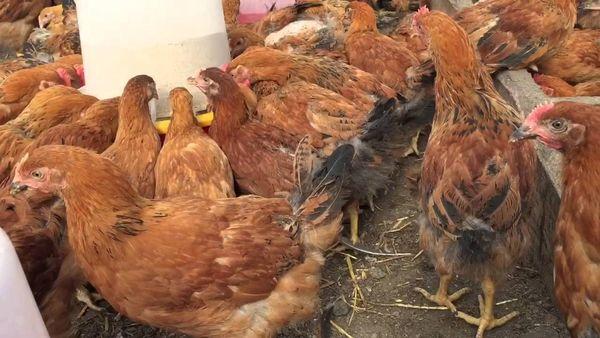
The laying hen is smaller in size, her head is light red. All feathers on the body of females have at least 2 fringes. The collar on the neck is black, and all the feather shafts and outlines are deep red. The color of the rest of the chicken feathers is dominated by a fiery red color and dark outlines.
Productive qualities
The breed has good vitality and rapid development. Roosters reach 3.5-3.8 kilograms, chickens - 2.5-2.8 kilograms. Chickens become sexually mature and begin to lay at the age of six months. Egg production is high - the laying hen gives up to 180-200 eggs per year. Kuchinki's eggs are rather large, light brown, with an average weight of 60.0 grams.
By the age of 3 weeks, the roosters gain weight up to 2.4 kilograms, and the hens are slightly smaller - up to 2.0 kilograms. When this age and weight is reached, young animals are slaughtered. Subsequently, the weight gain decreases, and the maintenance of the bird becomes unprofitable.
The nature of the birds
They are unpretentious, quickly adapt to a new place and get used to the owners, docile, do not show any aggression. But when strangers enter their territory, they show hostility. Therefore, when growing the Kuchin breed, they are allocated a separate room, no other bird can be added to them. As well as adding them to another breed of poultry, it will end fatally.
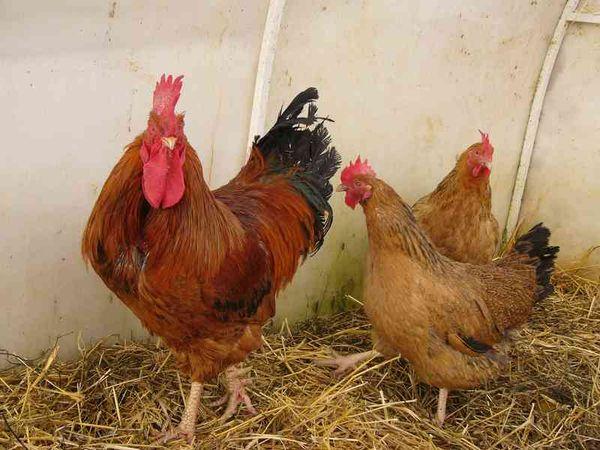
Main pros and cons
Like any breed of bird, Kuchin chickens have pros and cons. But, to Kuchinka's honor, there are much more advantages, for this poultry farmers and ordinary summer residents appreciate and love them.
Strengths:
- the breed is distinguished by its versatility and unpretentiousness, it is suitable for growing both on a personal backyard and on large poultry farms;
- chickens can be distinguished by sex even at day old;
- the breed is adapted to the harsh winter; they tolerate frost well, chickens even like to walk in the snow;
- chickens gain weight quickly;
- roosters and chickens are distinguished by tasty meat and high productivity;
- good immunity to diseases;
- developed maternal instinct;
- high survival rate of chickens.
Weaknesses:
- chickens of the Kuchin breed are prone to obesity in the second year of life;
- after the third year of life, the egg production of chickens falls noticeably;
- chickens are hostile to other breeds, and roosters show pronounced aggression.
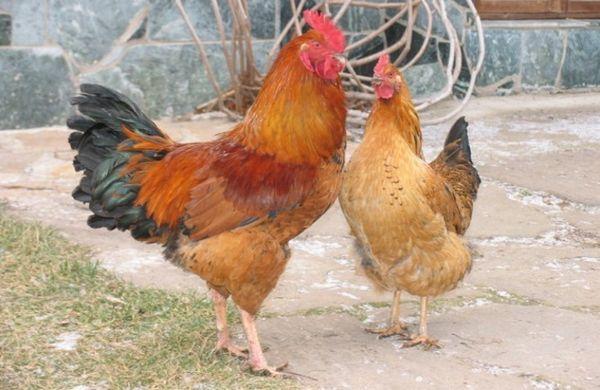
Care and maintenance
Raising chickens of the Kuchin breed does not require any special requirements, skills or abilities. Everything is standard, but you need to take into account some features of these birds.
House requirements
Chickens are kept both outdoors - in a barn, with the establishment of perches and equipment for a walking yard, and special cages are made. The cage option is preferable when raising chickens of different breeds together. Separate housing helps in the fight against the occurrence of diseases and allows metered feed delivery, preventing overfeeding of birds.
What should be the outdoor yard?
Directly next to the chicken coop there should be a walking yard, the size of which depends on the number of birds. It is fenced off from the main economic territory by a fence, which the chickens cannot flutter about.
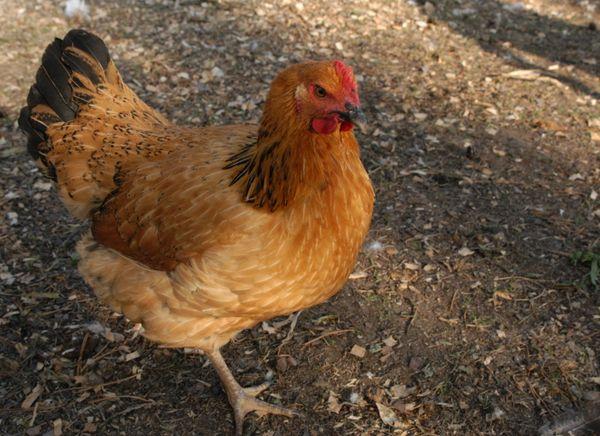
Usually they use a popular and effective option - they pull a netting around the perimeter. That's right, if the courtyard for walking chickens is shaded by trees. Many poultry houses hang shade nets over the entire area, saving birds from the summer heat, as well as attacks of birds of prey and animals dangerous for chickens - ferrets.
Installation of feeders and drinkers
The feeder is made of metal or wood. It is a low and long container attached to the wall of a shed or installed on the floor. Moreover, they are installed at a low height so that the chickens can easily reach the feed. The length of the feeder directly depends on the number of birds.
One chicken needs 10 centimeters of a feeder, otherwise some may overeat, others starve or fight for food.
Drinking bowls, however, like feeders, should be located both in the chicken coop and in the outdoor yard. They should be designed so that birds can easily get to the water, but prevents them from getting dirty or splashing liquid. The volume of the drinker should not be more than 5 liters, otherwise the water will sour and deteriorate, especially in the heat. And this can lead to diseases of birds.
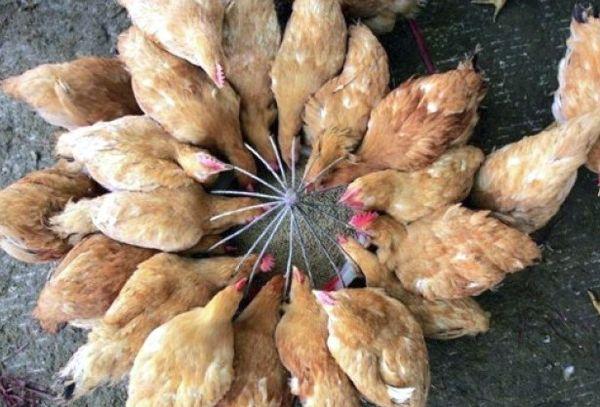
Laying cycle, molt
The molting period in Kuchin chickens is rather short - only 1 month, while in other breeds it is 3-4 months. During this short period, the chickens stop laying. During molting, you need to pay more attention to the chickens, increase the diet with vitamins, chop up greens, add fish oil and fresh vegetables.
Planned herd replacement
Chickens of the Kuchinsky breed rush for 3 years, after this period it is necessary to replace the herd. Old layers are slaughtered - for meat, and the younger generation comes to replace them. It is important to buy chicks from trusted sellers to avoid buying sick or weak birds, and also to be completely confident in buying chickens of the breed you need.
Bird diet
Feeding and directly the diet of Kuchin breed chickens is simple, familiar to ordinary chickens, without any special difficulties or requirements. They are not picky in nutrition, but the poultry farmer needs to know that the productivity of layers and the quality of chicken meat depend on the balance and nutritional value of the diet.

Proper nutrition is one of the keys to obtaining the desired result when growing Kuchinka.
Chick feeding
At the beginning of life, they are fed with boiled, crushed eggs, previously boned in semolina. Little by little, shredded greens, nutritional protein supplements, finely chopped root vegetables and bone meal are introduced into the diet. Effective feeding with ready-made nutrient mixtures (starters) for chickens containing the necessary nutrients and vitamins.
Food for adults
For the full development of adult chickens, the diet must necessarily contain grain of various varieties, as well as, in constant access, food additives containing minerals and vitamins. It is necessary to feed with wet mash and protein feed. This is important for the chickens to gain net weight.
A good option would be to include dry universal feed in the diet. Such feeds are well balanced, full of the whole spectrum of vitamins and proteins. When feeding with high-quality mixtures, layers significantly increase egg production, birds quickly gain weight, and therefore, it is possible to get great results in less time.

How to breed the breed correctly?
When breeding poultry at home, for a personal backyard, breeding individuals, hatching eggs or chickens of the Kuchin breed are purchased from trusted sellers. The breed has long been widespread throughout the country, so there will be no problems with finding a seller and buying.
Kuchin chickens are good brood hens, not only hatch eggs, but also hatch young, and even of other breeds.One hen is capable of hatching up to 30 chickens at once.
After birth, chickens need a lot of heat, they are kept in a warm, fairly light and always dry room. The temperature for the first 7-10 days should be +30 C degrees, and then it is gradually lowered to +20 C degrees.
Diseases of Kuchin chickens
Chickens of this breed have an innate strong immunity, are resistant to many diseases. But various parasites are affected, including helminths. For prevention, they put containers with ash near the feeder and regularly clean it, and also treat the chicken coop from parasites. Several times a season they are given drugs for the prevention of helminths (worms).

